Red birds are a common sight in the United States, with several species found throughout the country. These vibrant birds are known for their striking red plumage, and their presence can bring cheer and beauty to any natural setting.
Some red birds, like the Northern Cardinal, are widely recognized and beloved for their appearance and song. Others, such as the vermilion flycatcher, are more elusive but still fascinating to observe.
Whether seen in a backyard garden, on a forested trail, or on a birdwatching excursion, red birds are a beloved part of the avian landscape in the USA.
1. Northern Cardinal
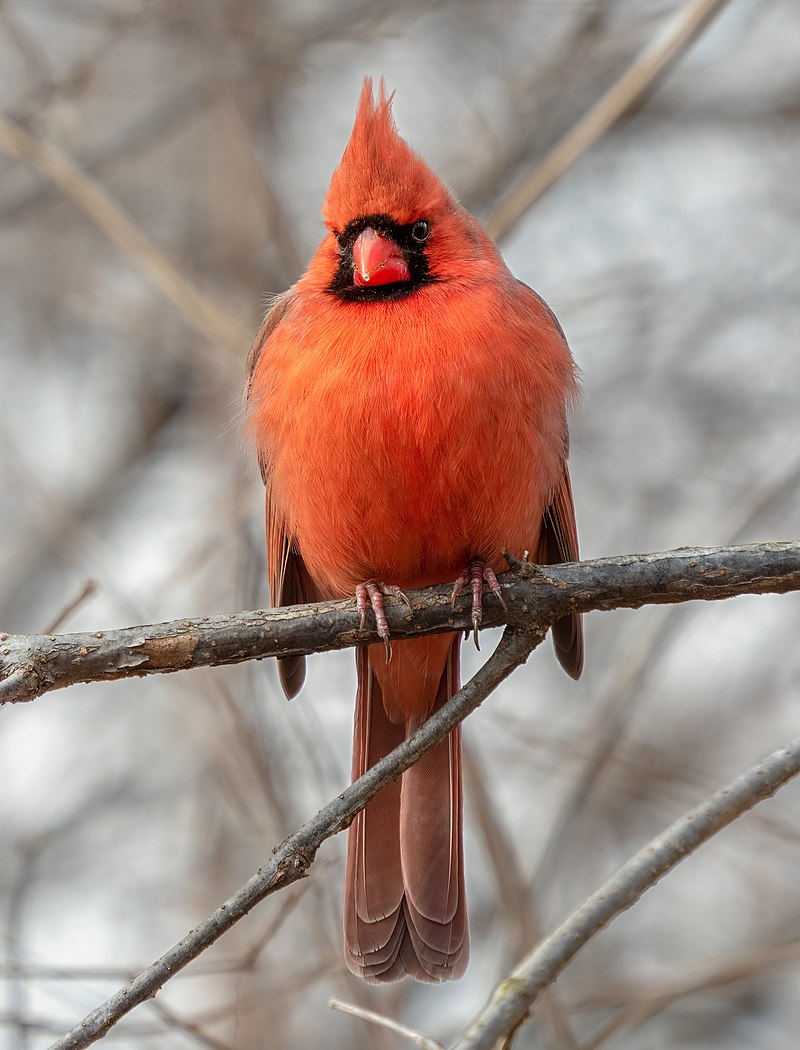
The Northern Cardinal is a beautiful bird, easily identified by its bright red plumage. It can be found in the eastern United States from Maine to Minnesota and south through Mexico and Belize.
Along with its striking colouration, it has a distinctive crest on its head and sharp black facial markings around the eyes.
Despite their small size (measuring 7-9 inches) they are very vocal birds – males sing persistently throughout springtime to attract mates or proclaim their territory.
They typically feed on insects, seeds and fruits but also enjoy suet at backyard bird feeders.
The female is less brightly coloured than her mate but still stands out among other songbirds due to her warm brownish-red feathers.
Cardinals pair for life so you may often see them together in your garden or neighbourhood park.Scientific classification:
| Kingdom | Animalia |
| Phylum | Chordata |
| Class | Aves |
| Order | Passeriformes |
| Family | Cardinalidae |
| Genus | Cardinalis |
| Species | C. cardinalis |
Also Featured In: Most Common United States Birds, Birds for Your Home Garden
2. American Robin

The American robin is a migratory bird, belonging to the true thrush genus and Turdidae family.
It was named after its European counterpart due to the similar reddish-orange breast they both possess; however, they are not related closely.
This species can be seen through most of North America during winter months, as well as in parts of Mexico and Central America where it also breeds.
They have plump bodies with gray upperparts and white underparts that vary from yellow on their throats down to orange toward their bellies.
Robins feed on fruits such as berries or insects like worms which makes them an important part of ecosystems by helping disperse seeds naturally throughout these areas.Scientific classification:
| Kingdom | Animalia |
| Phylum | Chordata |
| Class | Aves |
| Order | Passeriformes |
| Family | Turdidae |
| Genus | Turdus |
| Species | T. migratorius |
Also Featured In: Blue Birds You’ll Found around Us, New Hampshire Birds You Should Know
3. Common Loon
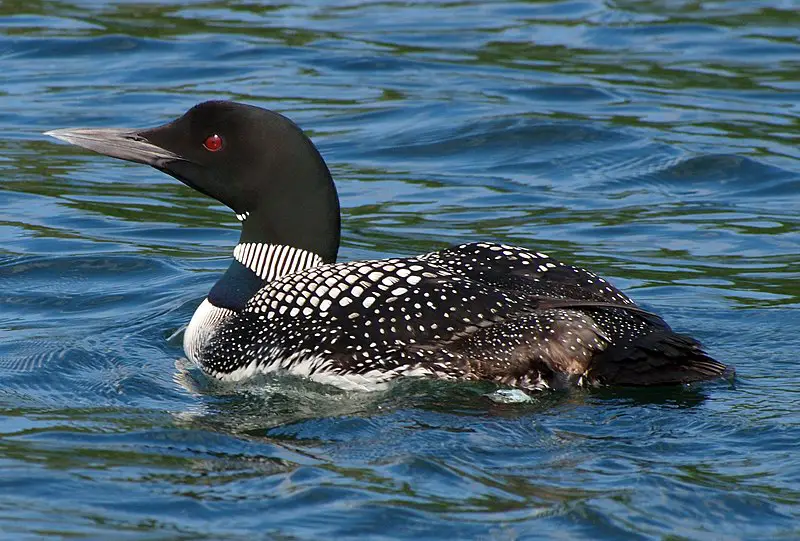
The Common Loon is a beautiful bird found in North America. It has a large black head and neck, with a greenish to purple sheen that stands out against its dark grey upperparts.
The underparts are pure white except for some black on the undertail coverts and vent.
During non-breeding season adults have brown plumage instead of the bright shades they show during breeding season.
They also exhibit unique behaviors such as diving underwater to catch fish or swimming along lakeshores while calling loudly, which is how they got their name “great northern diver”.
With their stunning colors and interesting behavior, it’s no wonder why these birds make up an iconic part of many landscapes across North America.Scientific classification:
| Kingdom | Animalia |
| Phylum | Chordata |
| Class | Aves |
| Order | Gaviiformes |
| Family | Gaviidae |
| Genus | Gavia |
| Species | G. immer |
Also Featured In: Water Birds Live around Us, British Columbian Birds
4. Downy Woodpecker
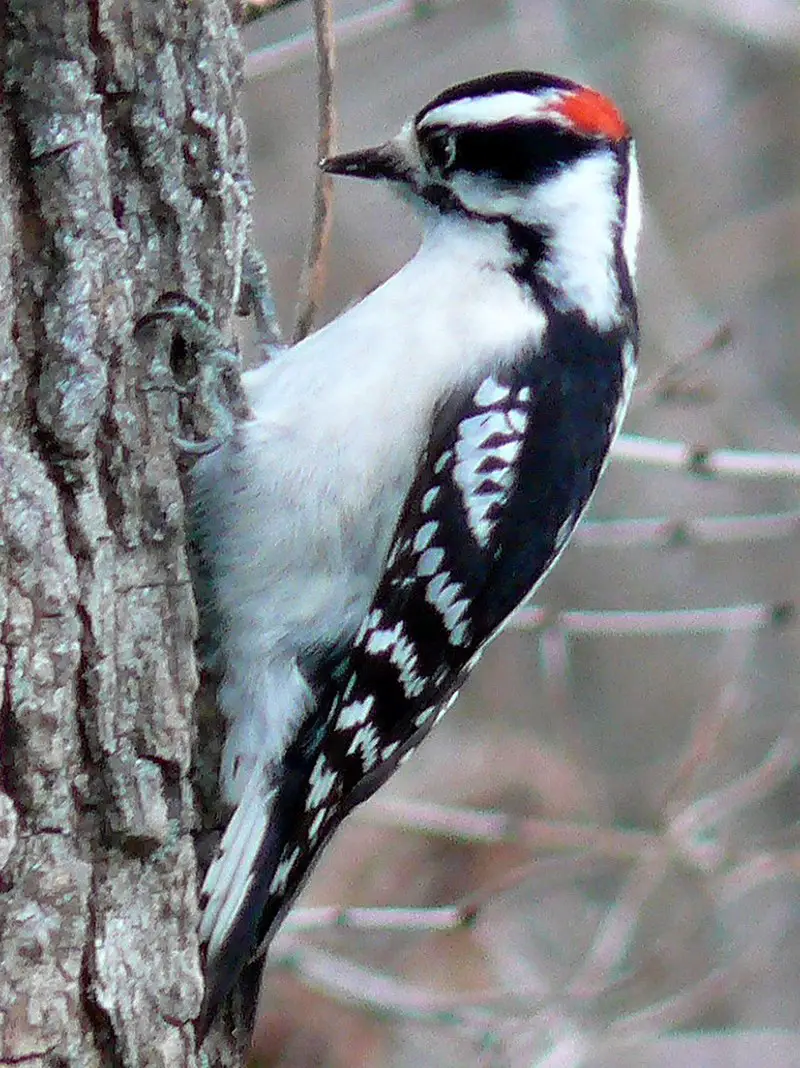
The downy woodpecker is a small species of woodpecker found in North America. Growing up to 7 inches long, it can be identified by its white belly and spotted wings.
It inhabits forests throughout the United States and Canada, with the exception of deserts in the southwest and northern tundra.
This bird nests in tree cavities and feeds mostly on insects but will supplement its diet with fruit or nuts when available.
The Downy Woodpecker has an unmistakable call that sounds like a loud ‘pik-er’, similar to other members of its family such as the Hairy Woodpecker.Scientific classification:
| Kingdom | Animalia |
| Phylum | Chordata |
| Class | Aves |
| Order | Piciformes |
| Family | Picidae |
| Genus | Dryobates |
| Species | D. pubescens |
Also Featured In: Long Island Birds You Should Know, Birds in Calgary You’ll Love to See
5. Red-Bellied Woodpecker
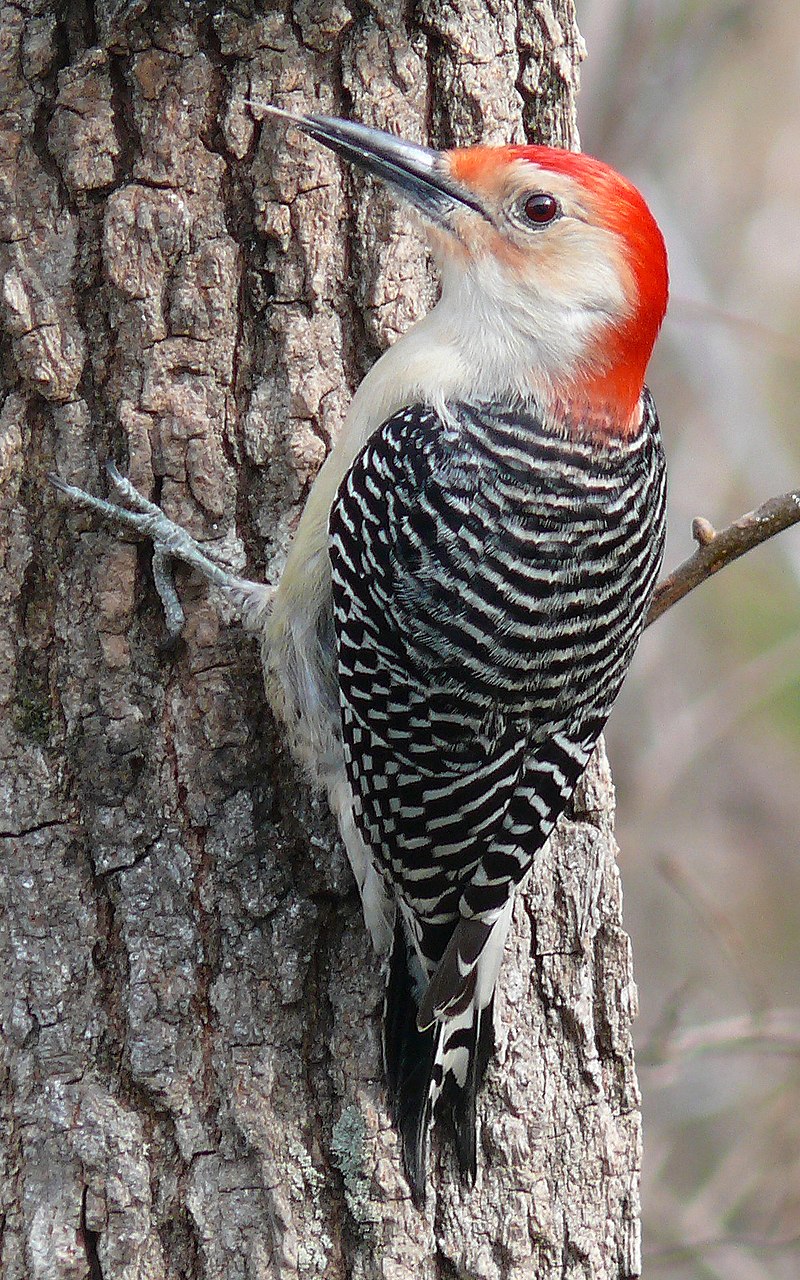
The Red-bellied woodpecker is a beautiful bird with an orange-red crown and nape. It breeds mainly in the eastern United States, ranging from Florida to Canada.
This medium-sized woodpecker of the family Picidae has black wings, white stripes on its back and tail feathers that are barred with black.
Its underside is mostly pale yellow or white but it also features some red coloration around its neck area.
Despite this subtle red hue, it should not be mistaken for the entirely red head and neck belonging to the Red-headed woodpecker of the same genus Melanerpes carolinus.
The Red bellied Woodpeckers diet consists primarily of insects such as ants, beetles and grasshoppers along with nuts fruits berries and tree sap which they will feed upon during different times throughout their life cycle.Scientific classification:
| Kingdom | Animalia |
| Phylum | Chordata |
| Class | Aves |
| Order | Piciformes |
| Family | Picidae |
| Genus | Melanerpes |
| Species | M. carolinus |
Also Featured In: Common Central Park Birds, Autumn Birds You Should Know
6. House Finch

The House Finch is a species of finch native to western North America and has been introduced in the eastern half of the continent as well as Hawaii.
It’s an average-sized finch with adults measuring 12.5 – 15 cm (5 – 6 inches) long and having wingspans between 20 – 25 cm (8 – 10 inches).
The upperparts are brown, while its underparts range from pale grayish white to yellow depending on subspecies.
Its face is streaked or spotted with reddish coloration; males typically have brighter plumage than females due to sexual dimorphism.
They’re mostly found near human habitations such as farms and gardens where they feed on grains, fruits, insects etc., making them very popular among birders who want something colorful for their backyard.Scientific classification:
| Kingdom | Animalia |
| Phylum | Chordata |
| Class | Aves |
| Order | Passeriformes |
| Family | Fringillidae |
| Subfamily | Carduelinae |
| Genus | Haemorhous |
| Species | H. mexicanus |
Also Featured In: Birds Live Near San Diego, Common Birds That Live in Las Vegas
7. Anna’s Hummingbird
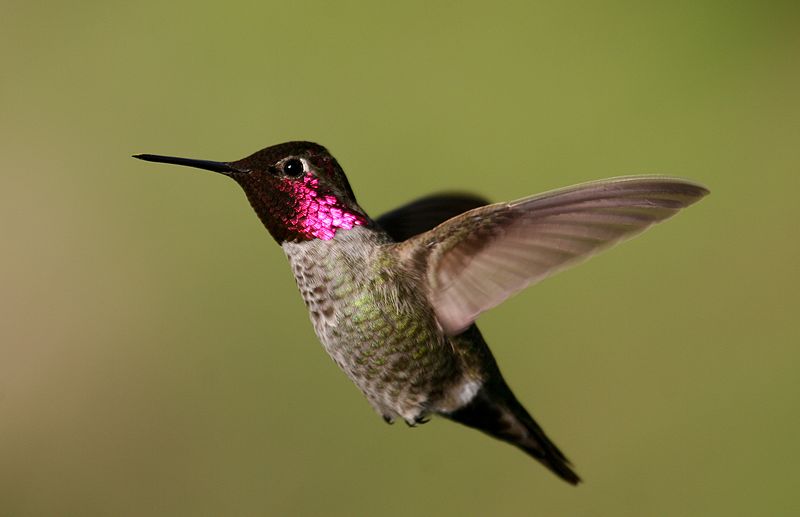
Anna’s hummingbird is a beautiful species of bird belonging to the Trochilidae family. Native to western coastal regions of North America, it was named after Anna Masséna, Duchess of Rivoli.
In the early 20th century, these birds bred only in northern Baja California and southern California but due to ornamental plant transplanting they can now be found across much of Pacific Coast region.
They are medium-sized with bright emerald green feathers on their back and crowns as well as rose-red patches at the throat for males which makes them quite distinguishable from other birds.
Their diet consists mainly nectar from flowers although they will occasionally feed on insects or spiders too making them important pollinators that help maintain healthy ecosystems.Scientific classification:
| Kingdom | Animalia |
| Phylum | Chordata |
| Class | Aves |
| Order | Apodiformes |
| Family | Trochilidae |
| Genus | Calypte |
| Species | C. anna |
Also Featured In: Flight Birds You Should Know, Common Southern Californian Birds
8. Tanagers
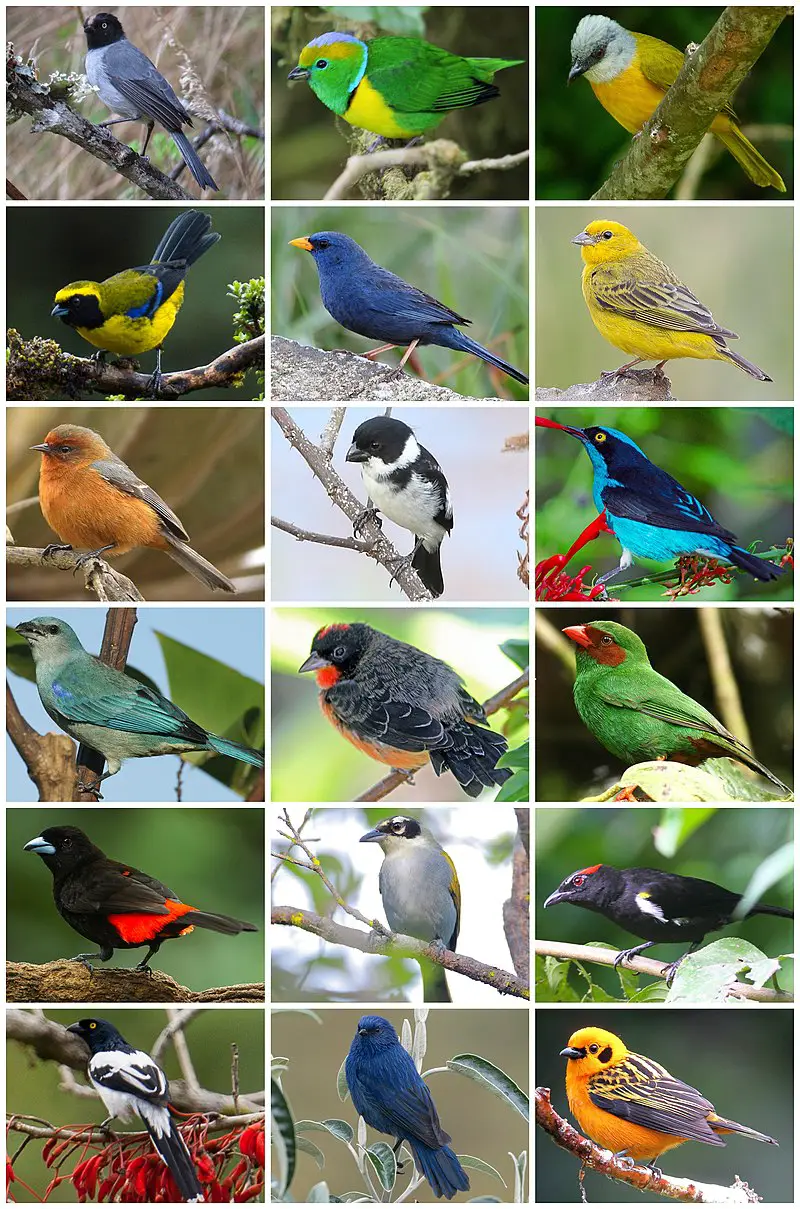
The Tanagers are a beautiful and diverse family of birds native to the Neotropical region. They boast an impressive array of colors, including blues, greens, yellows and reds.
The most common type is the fruit-eating tanager that can be found in tropical forests across Latin America. With nearly 240 species worldwide, they represent almost 4% of all avian species.
These vibrant birds have adapted well to their environment due to their strong bills used for cracking open hard fruits as well as sharp claws for gripping branches while feeding or perching.
As with many other bird families there is natural variation among populations making each one unique in its own way; something that makes them even more special.Scientific classification:
| Kingdom | Animalia |
| Phylum | Chordata |
| Class | Aves |
| Order | Passeriformes |
| Superfamily | Emberizoidea |
| Family | Thraupidae Cabanis, 1847 |
Also Featured In: Beautiful Brazilian Birds, Birds that Live in Guyana
9. Scarlet Macaw
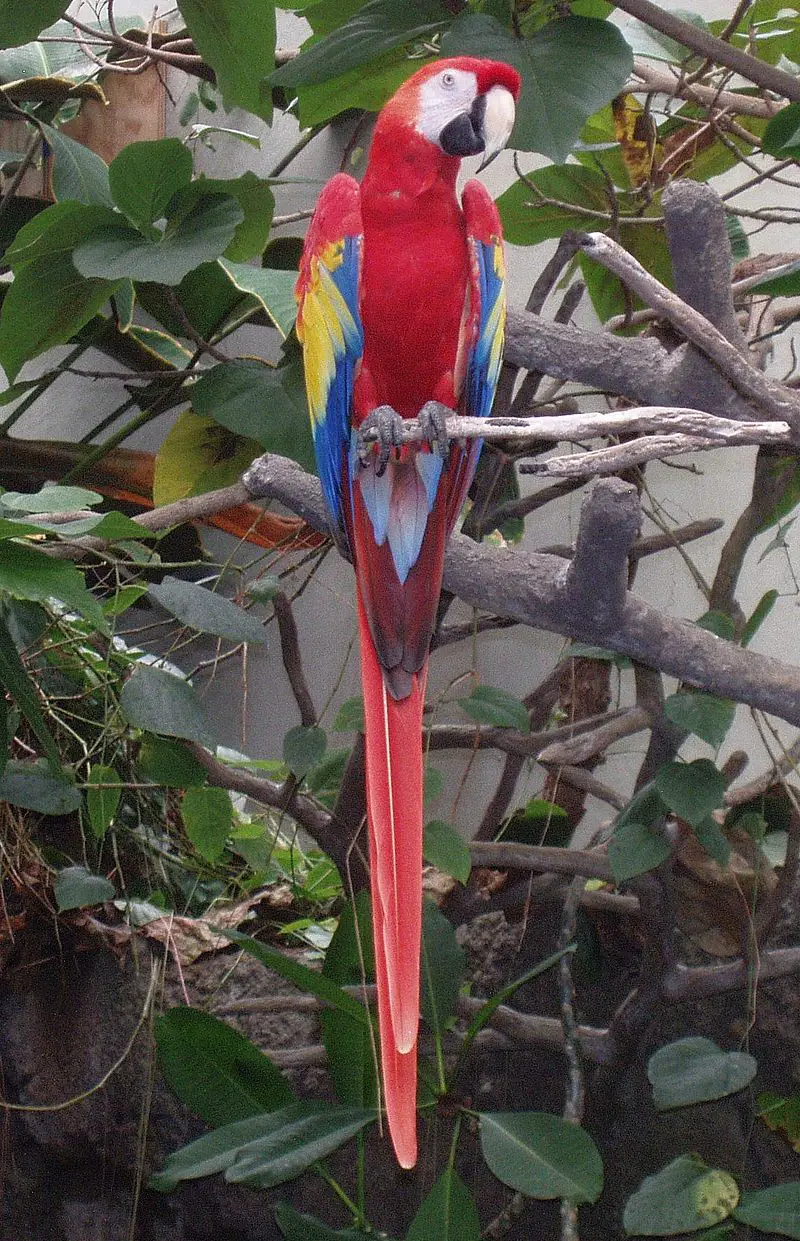
The Scarlet Macaw is a vibrant and beautiful bird found in Central and South America. Its striking red, yellow, and blue feathers make it stand out among other parrots.
It inhabits humid evergreen forests of the Neotropics from Mexico to Peru, Ecuador, Colombia, Bolivia Venezuela Brazil up to an altitude of 1000m (3300ft).
These birds have strong beaks which they use for breaking open hard nuts or seeds that would otherwise remain inaccessible.
They also form social bonds with their mates by grooming eachothers’ feathers and engaging in playful activities such as chasing one another around tree trunks.
Despite its vivid colors the Scarlet Macaw remains vulnerable due to habitat loss caused by deforestation so conservation efforts are essential if this amazing species is going to survive for future generations.Scientific classification:
| Kingdom | Animalia |
| Phylum | Chordata |
| Class | Aves |
| Order | Psittaciformes |
| Family | Psittacidae |
| Genus | Ara |
| Species | A. macao |
Also Featured In: Birds That Live in the Jungle, Rainforest Birds You Should Know
10. Passerine
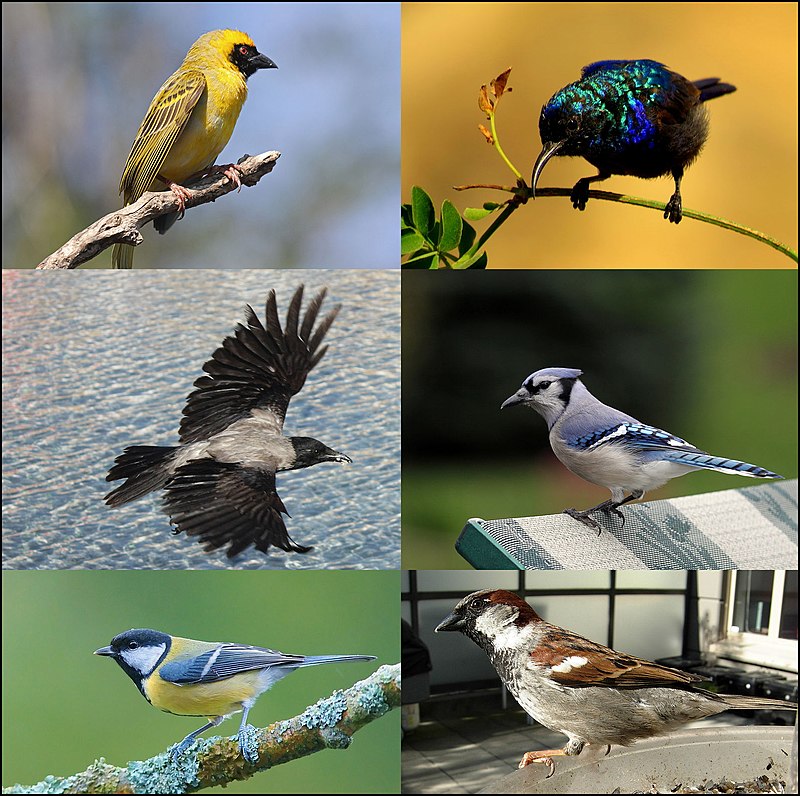
Passerines are a vast order of birds, comprising more than half the species in existence. Many familiar garden and woodland species fall into this category such as sparrows, blackbirds, finches and warblers.
They can be recognised by their arrangement of toes; three pointing forward with one back which helps them perch on branches or wires.
Passerines range from tiny wrens to large crows and have adapted to inhabit many environments around the world including forests, mountainsides and deserts.
They feed mainly on insects but some also consume fruit and seeds depending on their diet preferences.
Their diversity is truly remarkable from vibrant coloured tropical parrots to drab winter thrushes – making passerine birds an integral part of our natural heritage.Scientific classification:
| Kingdom | Animalia |
| Phylum | Chordata |
| Class | Aves |
| Clade | Psittacopasserae |
| Order | Passeriformes Linnaeus, 1758 |
Also Featured In: Egyptian Birds, Turkey Birds You Should Know
11. Ringed Kingfisher
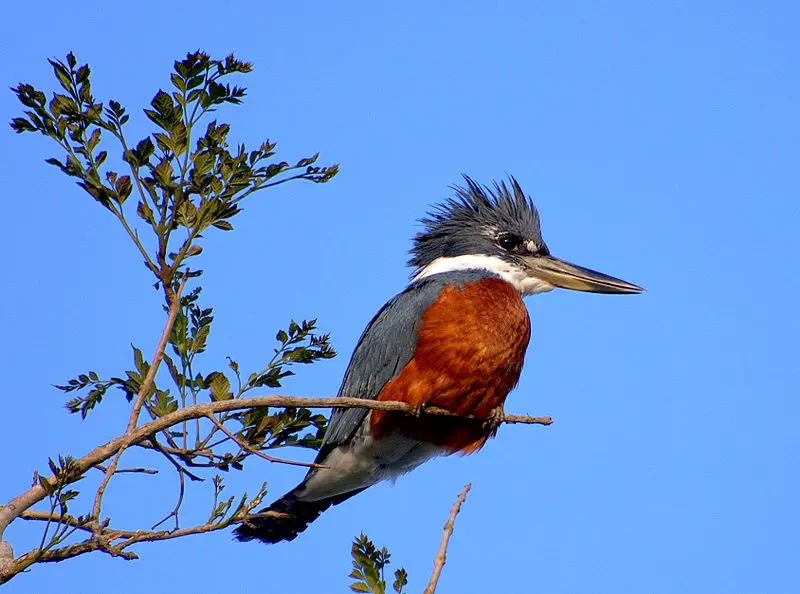
The Ringed Kingfisher is a large, vibrant bird that can be easily noticed by its loud call. It’s found in tropical regions from the lower Rio Grande Valley of southeastern Texas to Central America and even as far south as Tierra del Fuego.
This ground-dwelling species prefers to inhabit open areas near water bodies like streams, rivers and lakes which provide them with plenty of food such as fish, amphibians, crustaceans and insects.
In 1888 it was first identified by ornithologist Frank Chapman who noted its distinct ring pattern on the breast area.
The upperparts are dark blue while underneath they have white spots around their neck and belly region along with pale brown wings tipped in black stripes making this species quite unique among other kingfishers.
They may look intimidating but these birds actually play an important role for humans since they help control insect populations thus helping maintain a healthy balance within our ecosystems.Scientific classification:
| Kingdom | Animalia |
| Phylum | Chordata |
| Class | Aves |
| Order | Coraciiformes |
| Family | Alcedinidae |
| Subfamily | Cerylinae |
| Genus | Megaceryle |
| Species | M. torquata |
Also Featured In: Common Birds in Colombia, Red Birds You’ll Commonly Found in Texas
12. American Flamingo
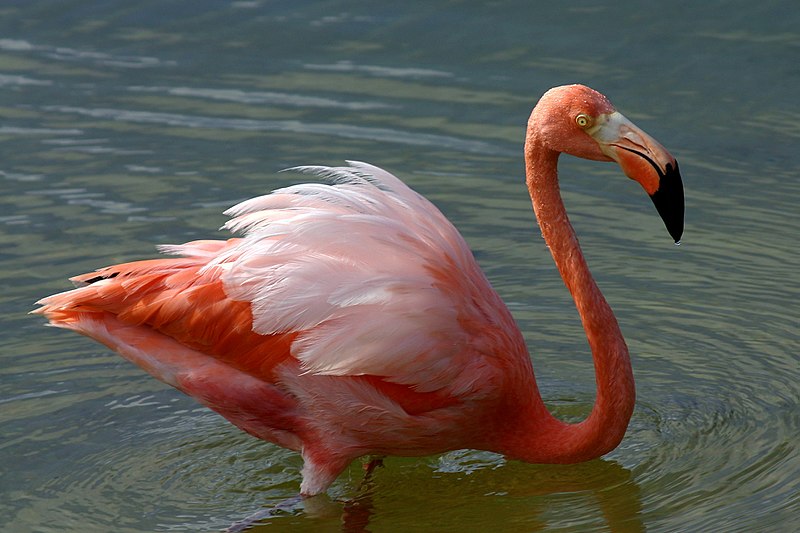
The American flamingo is a large species of bird found in the Neotropics. It has bright pink feathers and long legs, making it easily distinguishable from other species of flamingos.
The diet consists mostly of shrimp and small fish but they are also known to eat algae, aquatic insects, mollusks, crustaceans and seeds.
They live around coastal lagoons or salt ponds in colonies with thousands of birds nesting together on mud flats.
Flamingos build nests out of sticks that sit atop their feet as they wade through shallow waters looking for food during low tide periods when these areas become more accessible for feeding purposes.
These birds have an interesting courtship ritual involving neck stretching which looks like a dance to attract mates before breeding season begins in May-June each year leading to chicks hatching during July-August time periodScientific classification:
| Kingdom | Animalia |
| Phylum | Chordata |
| Class | Aves |
| Order | Phoenicopteriformes |
| Family | Phoenicopteridae |
| Genus | Phoenicopterus |
| Species | P. ruber |
Also Featured In: Birds You’ll Find in Zoo, Galapagos Birds You Should Know
13. Cardinal
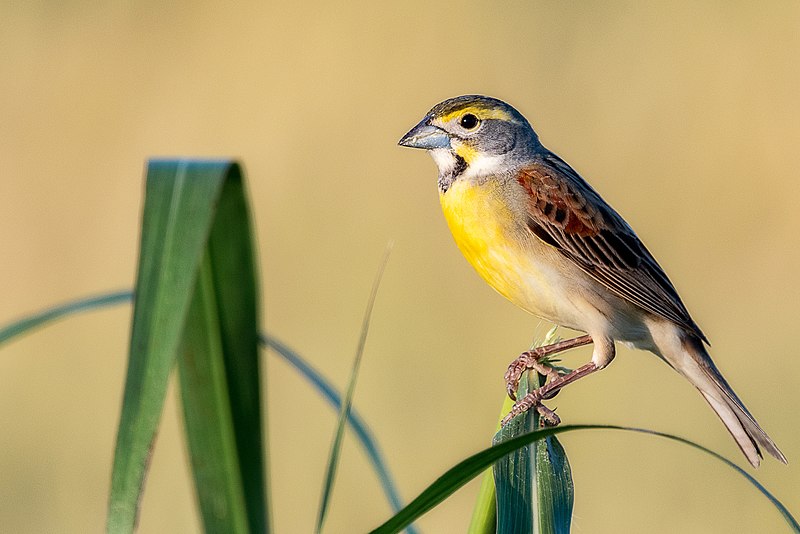
Cardinalidae is a family of passerine birds endemic to the New World that includes cardinals, grosbeaks and buntings.
This large group has great diversity in its members which range from tanager-like Piranga to warbler-like Granatellus.
They are usually distinguished by their bright plumage with reds, oranges and yellows being common among them.
Their strong bills enable them to feed on seeds, fruits and insects as well as other small prey items like lizards or frogs depending upon species.
Cardinals also have loud calls often used for territorial defense and courtship purposes while some can even imitate sounds made by other animals.
These adaptable birds inhabit a variety of habitats across North America making them an important part of many ecosystems there.Scientific classification:
| Kingdom | Animalia |
| Phylum | Chordata |
| Class | Aves |
| Order | Passeriformes |
| Superfamily | Emberizoidea |
| Family | Cardinalidae Ridgway, 1901 |
Also Featured In: Common Birds in Canada, Famous Paintings Birds
14. Pine Grosbeak
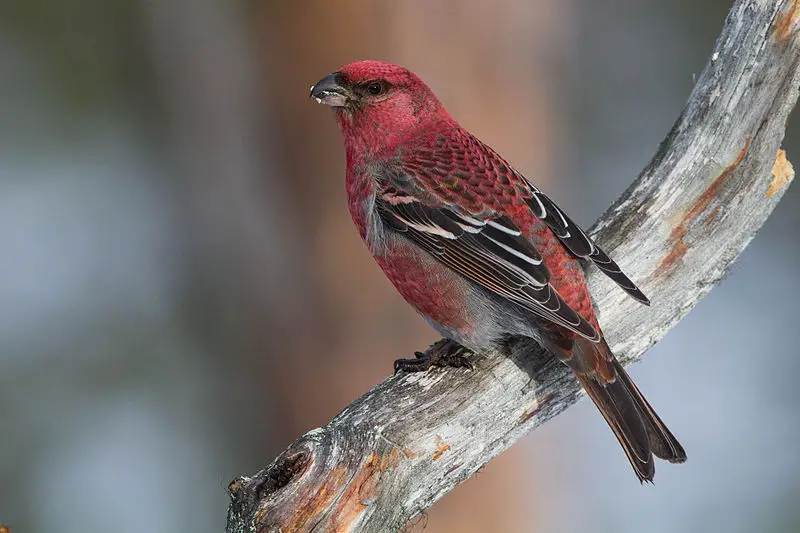
Pine grosbeak is a beautiful bird found across Alaska, western US, Canada and Fennoscandia to Siberia. It belongs to the family of true finch and it is the only species in its genus Pinicola.
This frugivorous bird has bright red feathers on its head and wings with yellowish white underparts that make it very attractive.
During winter season they feed mostly on small fruits like rowans, blueberries etc., while during summer months their diet consists mainly of insects.
They are shy birds but can be seen perched at high branches or singing from the topmost trees if you look carefully enough.Scientific classification:
| Kingdom | Animalia |
| Phylum | Chordata |
| Class | Aves |
| Order | Passeriformes |
| Family | Fringillidae |
| Subfamily | Carduelinae |
| Genus | Pinicola Vieillot, 1808 |
| Species | P. enucleator |
Also Featured In: Birds of Nova Scotia, Spiritual Birds
15. Rosellas
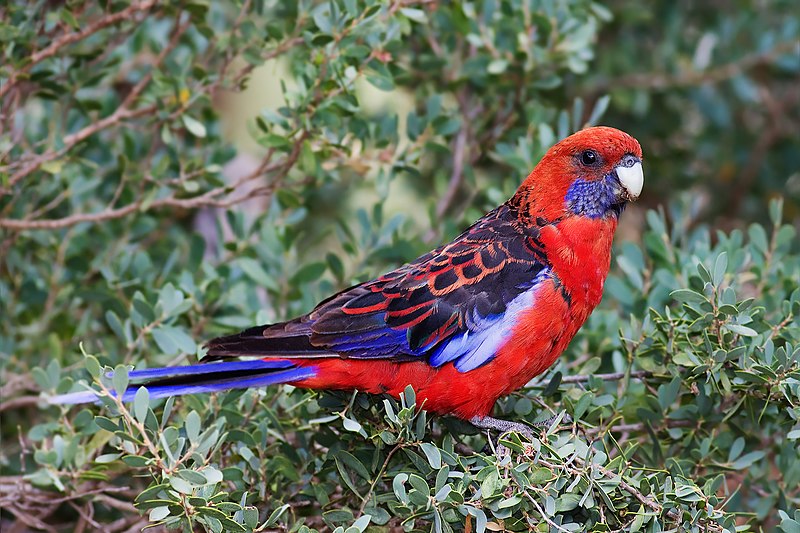
Rosellas are beautiful, colorful parrots native to Australia that belong to the genus Platycercus. They have broad tails and a diet consisting mainly of seeds and fruit.
There are six species with 19 subspecies in total. Their bright plumage is one of their most distinctive features, making them popular among bird enthusiasts around the world.
Rosellas can be seen perched on tree branches or flying freely through woodlands across much of Australia’s eastern coast as well as Tasmania’s south-western regions.
Many people enjoy having rosellas as pets due to their attractive colors and lively personalities.Scientific classification:
| Kingdom | Animalia |
| Phylum | Chordata |
| Class | Aves |
| Order | Psittaciformes |
| Family | Psittaculidae |
| Tribe | Platycercini |
| Genus | Platycercus Vigors, 1825 |
Also Featured In: Most common birds in Australia, Sydney Birds You Need to See
16. Roseate Spoonbill
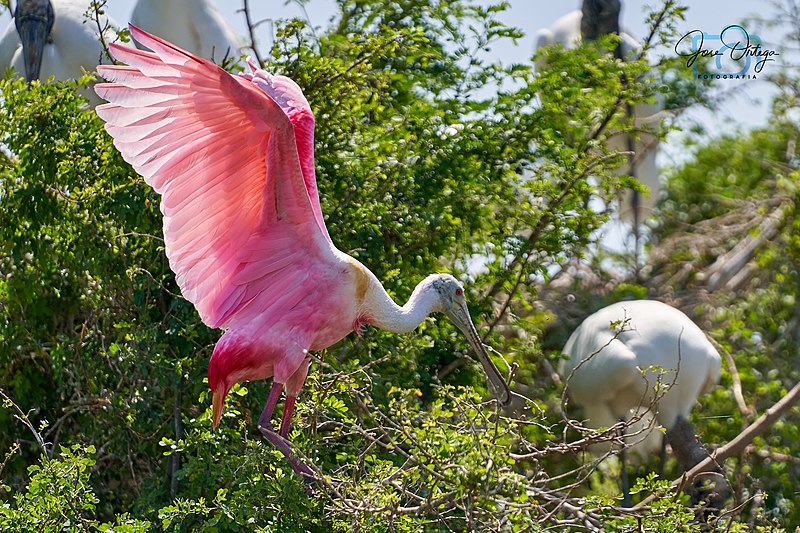
The Roseate Spoonbill is a beautiful and majestic bird found in both North and South America.
It belongs to the ibis family, Threskiornithidae, and its vibrant pink colour comes from canthaxanthin pigment derived from their diet of crustaceans like shrimp.
Sadly plume hunting has almost driven this species close to extinction during the 18th and 19th centuries but fortunately it’s making a comeback due to conservation efforts made by dedicated wildlife organisations.
Its large spoon-like bill helps them filter out food sources such as small fish or frogs from shallow water areas while they wade through mudflats with their long legs looking for something tasty.
With its unique appearance, graceful wingspan amd impressive flight capabilities, the Roseate Spoonbill is an incredibly photogenic animal that will captivate any viewers attention who happen to be lucky enough witness it in all its glory.Scientific classification:
| Kingdom | Animalia |
| Phylum | Chordata |
| Class | Aves |
| Order | Pelecaniformes |
| Family | Threskiornithidae |
| Genus | Platalea |
| Species | P. ajaja |
Also Featured In: Costa Rica Birds, Everglades Birds
17. Ruby-Throated Hummingbird
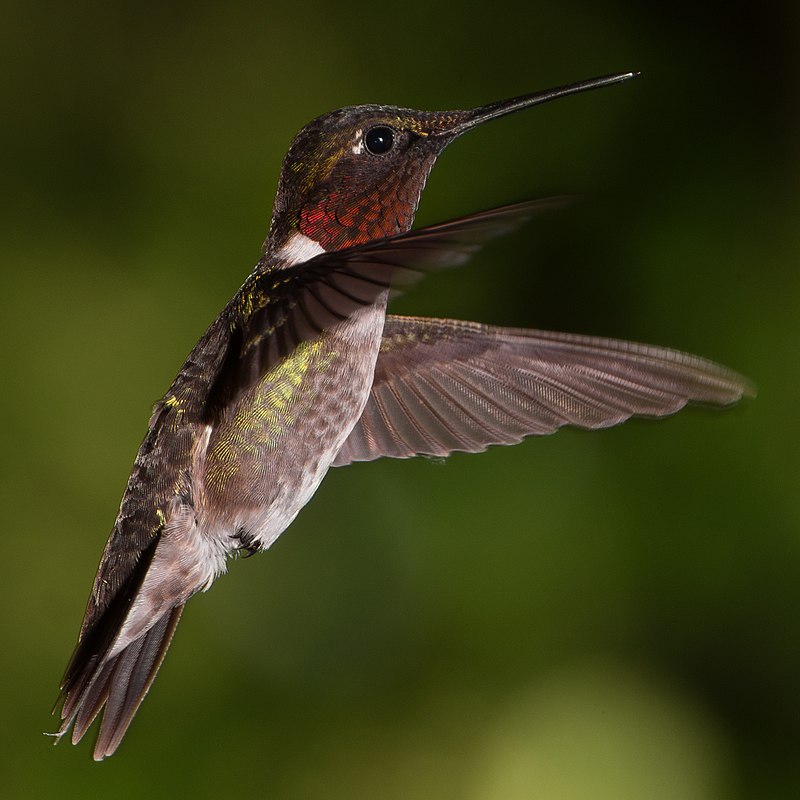
The ruby-throated hummingbird (Archilochus colubris) is a species of hummingbird that has an impressive migration pattern, spending the winter in Central America, Mexico and Florida before flying to Canada and other parts of Eastern North America for breeding season.
It’s by far the most common type seen east of the Mississippi River in North America.
Formally described by Swedish naturalist Carl Linnaeus in 1758, this tiny bird has bright metallic green upperparts with white underparts, a small black bill and a red throat patch which gives it its name; they measure around 3 inches long on average.
They feed primarily on nectar from flowers but also eat insects such as flies or mosquitoes for extra protein during their migrations or when raising young chicks.Scientific classification:
| Kingdom | Animalia |
| Phylum | Chordata |
| Class | Aves |
| Order | Apodiformes |
| Family | Trochilidae |
| Genus | Archilochus |
| Species | A. colubris |
Also Featured In: Georgia Birds, Birds that Live in Mississippi
18. Red-Headed Woodpecker
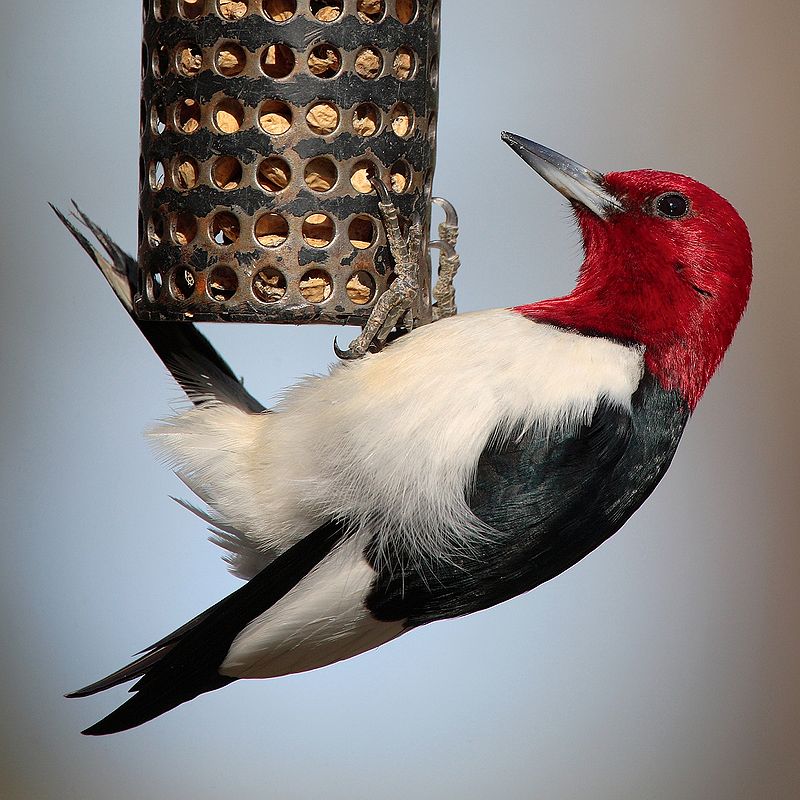
The red-headed woodpecker is a mid-sized bird found in temperate North America. It has striking plumage, with its head and neck being bright red while the rest of its body is primarily black and white.
Its wings are rounder than other similar species, allowing it to maneuver through tight spaces easily when searching for food or shelter.
The breeding habitat of this bird consists mainly of open fields across Canada and the east-central United States.
Despite facing threats such as deforestation, urbanization, predation from larger birds, collisions with windows or cars due to their inquisitive nature.
These birds remain listed on IUCN’s Red List as least concern thanks largely in part to conservation efforts by local governments and organizations dedicated to protecting wildlife habitats.Scientific classification:
| Kingdom | Animalia |
| Phylum | Chordata |
| Class | Aves |
| Order | Piciformes |
| Family | Picidae |
| Genus | Melanerpes |
| Species | M. erythrocephalus |
Also Featured In: Red Birds that Live in Tennessee, Red Birds that Live in Kentucky
19. Purple Finch
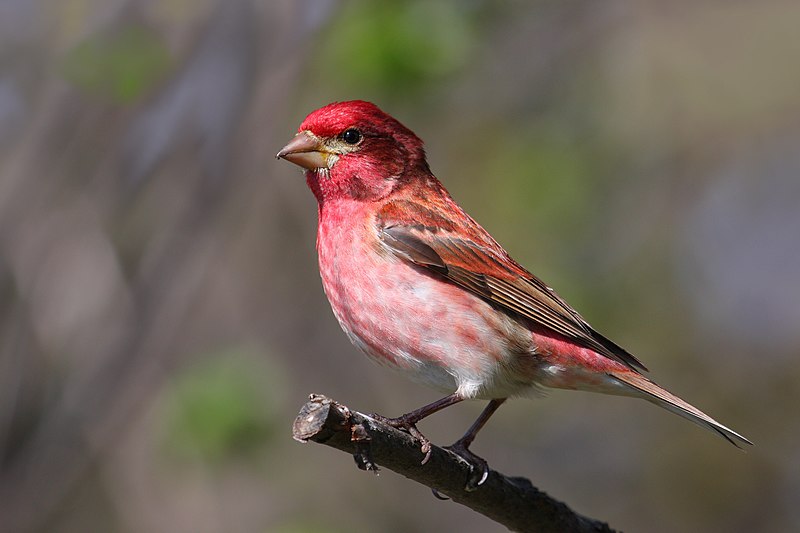
The Purple Finch is a species of finch from North America, belonging to the Fringillidae family.
It’s also known as an “American Rosefinch” due to its resemblance in color and size to some European rosefinches.
Their plumage ranges from pinkish-purple on their heads and wings, with a light brown underside.
They are small birds that measure about 5-6 inches long with short thin beaks for eating seeds and insects.
In addition, they have thick round bodies which help them stay warm during cold winters in the northern parts of their range.
The Purple Finch has adapted well over time making it easier for them to survive even though there are increasing threats posed by humans such as deforestation or habitat destruction caused by development projects near their habitats.Scientific classification:
| Kingdom | Animalia |
| Phylum | Chordata |
| Class | Aves |
| Order | Passeriformes |
| Family | Fringillidae |
| Subfamily | Carduelinae |
| Genus | Haemorhous |
| Species | H. purpureus |
Also Featured In: Magenta Birds You Didn’t Know, Birds in Iowa Spring
20. Scarlet Tanager
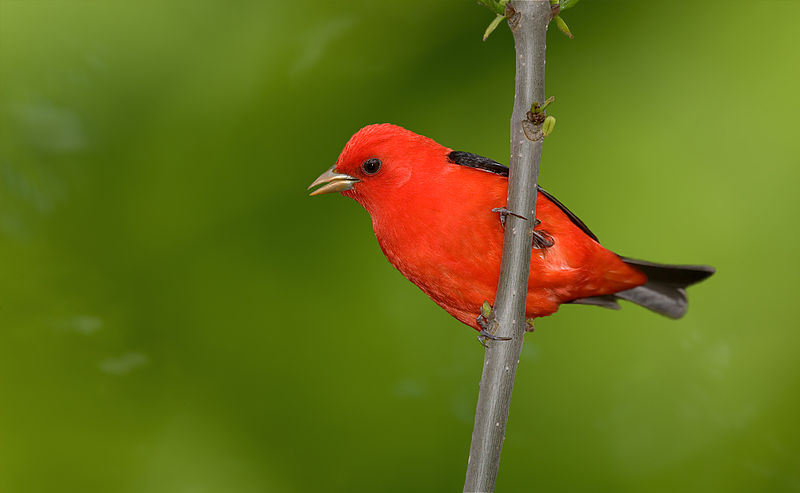
The Scarlet Tanager is a beautiful medium-sized bird found in parts of North and South America. It belongs to the Cardinal family, and has striking red plumage with black wings and tail feathers.
Its song is similar to other cardinals yet also unique in its own way – it’s recognizable by its high whistles that become lower towards the end.
The species feeds mainly on insects as well as berries from trees or shrubs during breeding season, when they may form loose flocks over open woodlands foraging for food.
They are highly territorial birds during nesting season which happens between April and June each year; both males and females fiercely defend their nests against intruders such as cats or squirrels.Scientific classification:
| Kingdom | Animalia |
| Phylum | Chordata |
| Class | Aves |
| Order | Passeriformes |
| Family | Cardinalidae |
| Genus | Piranga |
| Species | P. olivacea |
Also Featured In: Yellow Connecticut Birds, Common Yellow Birds of Idaho
21. Common Redpoll
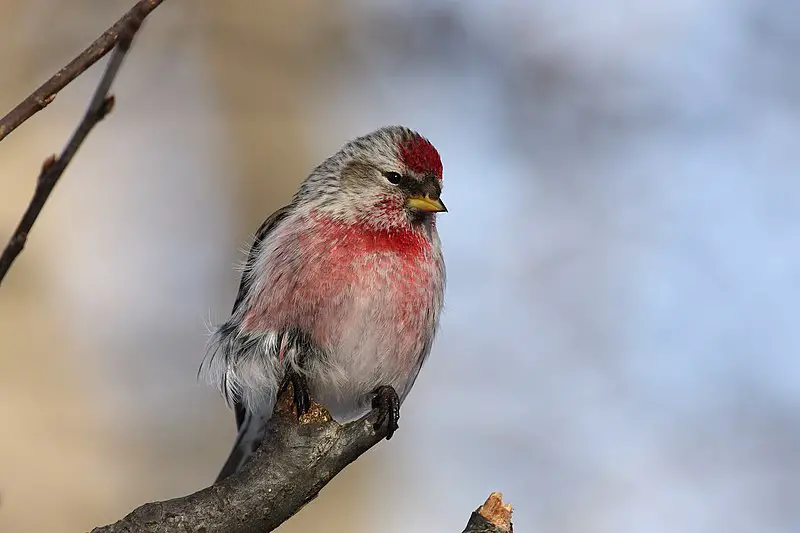
The Common Redpoll is a species of bird belonging to the finch family. It has an orange-red crown, white breast and grey back with two black stripes running down either side.
Its wings are barred in browns and its tail feathers have a grayish tinge at their tips. The redpoll breeds mainly south from Arctic regions in habitats that contain shrubs or thickets.
First classified by Linnaeus in 1758 under the binomial name Fringilla flammea, it’s genus Acanthis originates from Ancient Greek akantha meaning “thorn” or “prickle”.
This small yet colourful bird feeds mainly on seeds such as thistles during summer months but switches over to birch catkins when winter arrives – making them a common sight throughout much of North America and Eurasia.Scientific classification:
| Kingdom | Animalia |
| Phylum | Chordata |
| Class | Aves |
| Order | Passeriformes |
| Family | Fringillidae |
| Subfamily | Carduelinae |
| Genus | Acanthis |
| Species | A. flammea |
Also Featured In: Finches Species, Most Common Winter Birds
22. Red Crossbill
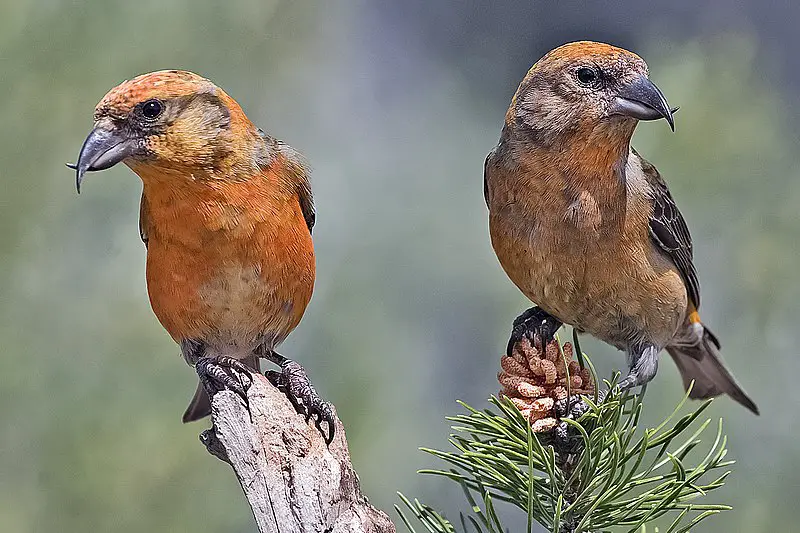
The Red Crossbill is a small passerine bird belonging to the finch family. It has distinctively crossed mandibles, which it uses to extract seeds from conifer cones and other fruits.
This species can be identified by its vivid colouring; males are red or orange in hue whilst females tend to have more green or yellow feathers.
Furthermore, there is considerable variation between individuals of this species when it comes to their beaks size and shape as well as their calls—which range from short trills through chirps and harsh cackles up until loud rattling sounds at times.
They’re an interesting sight in many parts of Europe, particularly during winter months where they often feed on pine cone seeds that drop down onto lower branches of trees.Scientific classification:
| Kingdom | Animalia |
| Phylum | Chordata |
| Class | Aves |
| Order | Passeriformes |
| Family | Fringillidae |
| Subfamily | Carduelinae |
| Genus | Loxia |
| Species | L. curvirostra |
Also Featured In: Common Birds in Saskatchewan, Common Birds in Alberta
23. Cassin’s Finch
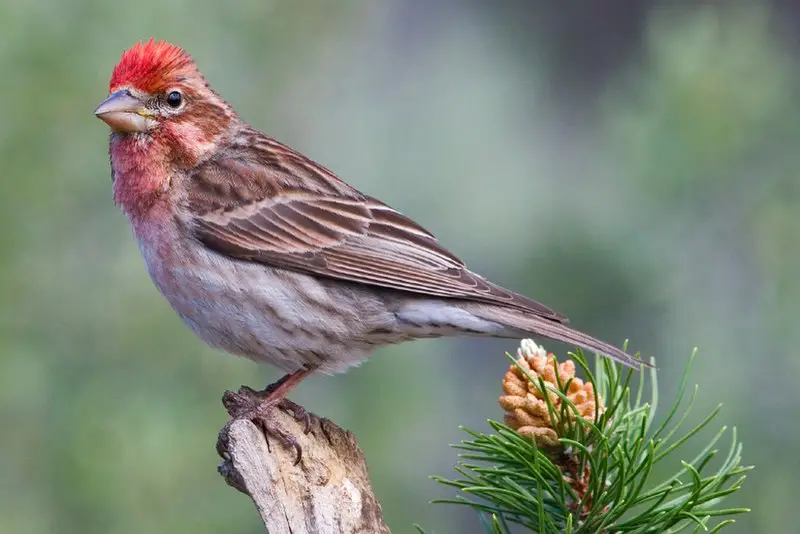
Cassin’s finch is a species of bird belonging to the Fringillidae family. It has brown wings and tail, with a longer bill than that of the purple finch.
Adult males are raspberry red on their head, breast, back and rump with streaked backs and undertail feathers.
The adult female Cassin’s Finch is duller in colouration than male but still shows pinkish tones around its face and neck area as well as subtle streaks across its body.
This species can be found mainly in western North America from Alaska down to California where they inhabit coniferous forests along mountain slopes or near riversides at elevations between 500-3000 meters above sea level.
They feed mainly on grasshoppers, caterpillars and other insects which they pick up while foraging through vegetation or by flying out onto open ground surfaces.Scientific classification:
| Kingdom | Animalia |
| Phylum | Chordata |
| Class | Aves |
| Order | Passeriformes |
| Family | Fringillidae |
| Subfamily | Carduelinae |
| Genus | Haemorhous |
| Species | H. cassinii |
Also Featured In: Red birds You’ll See in Arizona, Red Birds You’ll See in Oklahoma
24. Black Rosy Finch
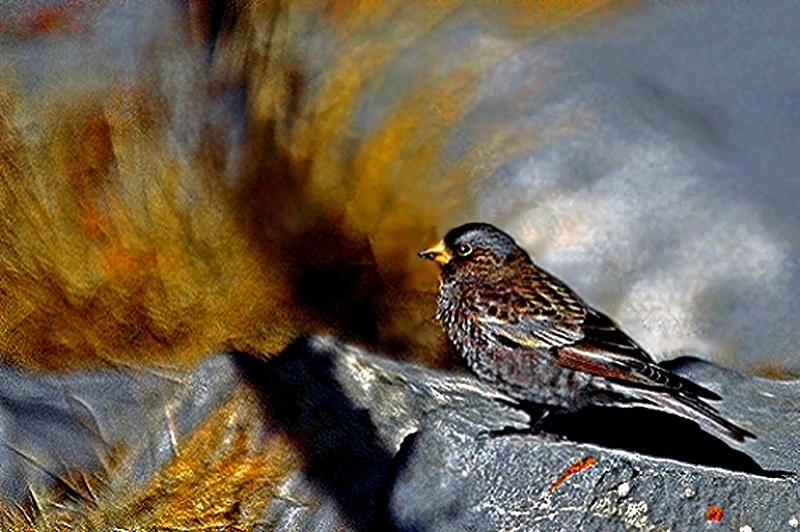
The Black Rosy Finch is a species of passerine bird in the family Fringillidae. It has an extremely limited range, primarily existing only in alpine areas above treeline in the western United States.
The first scientific description of this bird was made by American ornithologist Robert Ridgway back in 1874, and it remains popular among photographers today due to its unique beauty and rarity.
The black rosy finch’s plumage consists mainly of gray-black feathers with some carmine patches on their wings, giving them their namesake “rosy” coloring.
They have short tails and slender beaks that allow them to feed on small seeds found high up in mountain shrubs or rocksides – they are also known as nimble climbers.
Overall, these birds remain a sight to behold for anyone lucky enough to spot one while hiking through the mountainside.Scientific classification:
| Kingdom | Animalia |
| Phylum | Chordata |
| Class | Aves |
| Order | Passeriformes |
| Family | Fringillidae |
| Subfamily | Carduelinae |
| Genus | Leucosticte |
| Species | L. atrata |
25. Gray-Crowned Rosy Finch
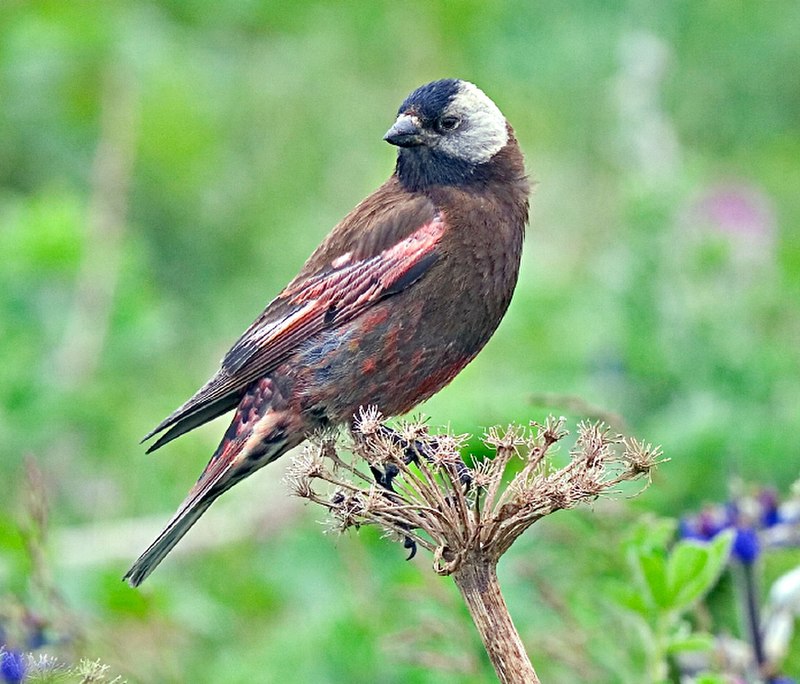
Gray-crowned rosy finches are a species of passerine bird from North America. They inhabit alpine regions, making them rarely seen in the wild and difficult to observe.
Six subspecies have been recognized and they belong to the family Fringillidae alongside three other types of Rosy Finches.
These birds have gray crowns with white throats that contrast against their black or brown heads and necks as well as their striped wings which can range from pinkish-brown to deep red depending on the location where it is observed.
The Gray-Crowned Rosy Finch has an impressive vocal repertoire composed mostly of chirps, buzzes, trills, whistles, twitters and warbles used for communication between individuals within its flock.
This bird’s diet consists mainly of vegetation such seedheads but also includes insects during breeding season when more food sources are availableScientific classification:
| Kingdom | Animalia |
| Phylum | Chordata |
| Class | Aves |
| Order | Passeriformes |
| Family | Fringillidae |
| Subfamily | Carduelinae |
| Genus | Leucosticte |
| Species | L. tephrocotis |
26. Brown-Capped Rosy Finch
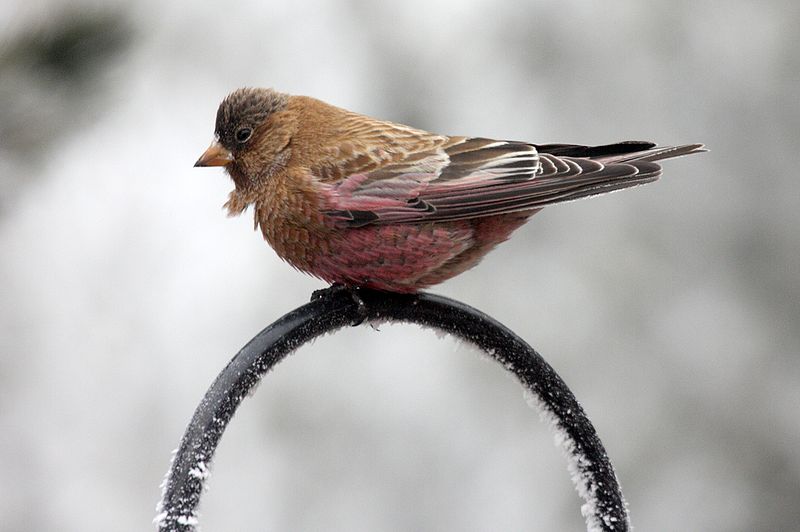
The Brown-capped Rosy Finch is a medium-sized finch native to North America. Its distinctive features include its brown head, back and breast with pink hues on the belly, rump and wings as well as a black forehead.
It also has short black legs and a long forked tail. These birds prefer mountain peaks in central Rocky Mountain areas of the United States where they build cup nests in cavities or cliffsides.
They are known to feed on grasses, grains and insects while migrating south during winter months when food resources become scarce at higher altitudes.
The Brown-capped Rosy Finch is an interesting species that adds colour among rocky landscapes.Scientific classification:
| Kingdom | Animalia |
| Phylum | Chordata |
| Class | Aves |
| Order | Passeriformes |
| Family | Fringillidae |
| Subfamily | Carduelinae |
| Genus | Leucosticte |
| Species | L. australis |
Also Featured In: Birds That Live in Colorado,
27. Two-Barred Crossbill
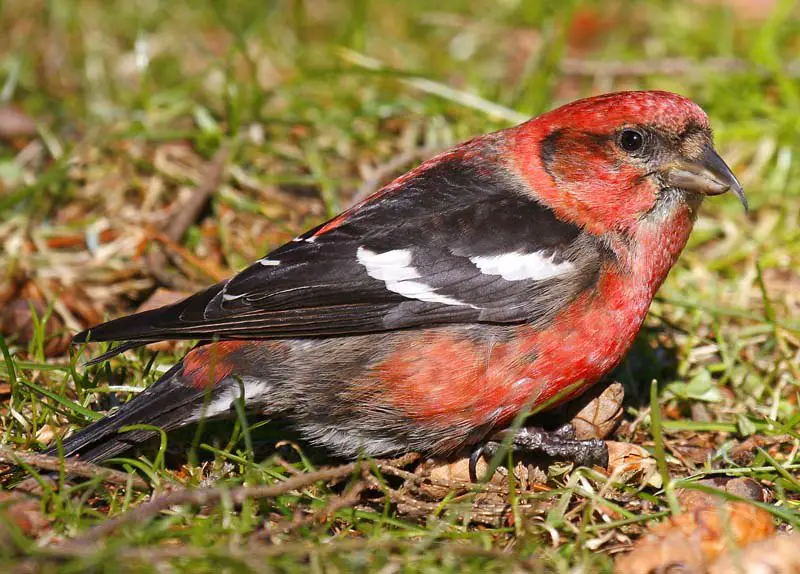
The Two-barred crossbill is a small passerine bird belonging to the finch family Fringillidae.
It gets its scientific name, Loxia leucoptera, from Ancient Greek – with ‘Loxia’ meaning ‘crosswise’ and ‘leucoptera’ translating to “white-winged” in reference to its white wings.
The species has two subspecies: the white-winged crossbill (Loxia leucoptera leucoptera) that can be found in North America and the two bar crossbill (Loxia leucocephala) which inhabits Europe, Asia as well as parts of northern Africa.
These birds feed mainly on conifer seeds but have also been seen consuming insects such as beetles or caterpillars during breeding season when food resources are scarce for their young ones.
They construct nests made out of twigs near trunks of spruce trees where they lay 2–6 eggs at one time.Scientific classification:
| Kingdom | Animalia |
| Phylum | Chordata |
| Class | Aves |
| Order | Passeriformes |
| Family | Fringillidae |
| Subfamily | Carduelinae |
| Genus | Loxia |
| Species | L. leucoptera |
Also Featured In: Birds that Migrate through Illinois in the Spring, Red Minnesota Birds You Need to Know
28. Arctic Redpoll
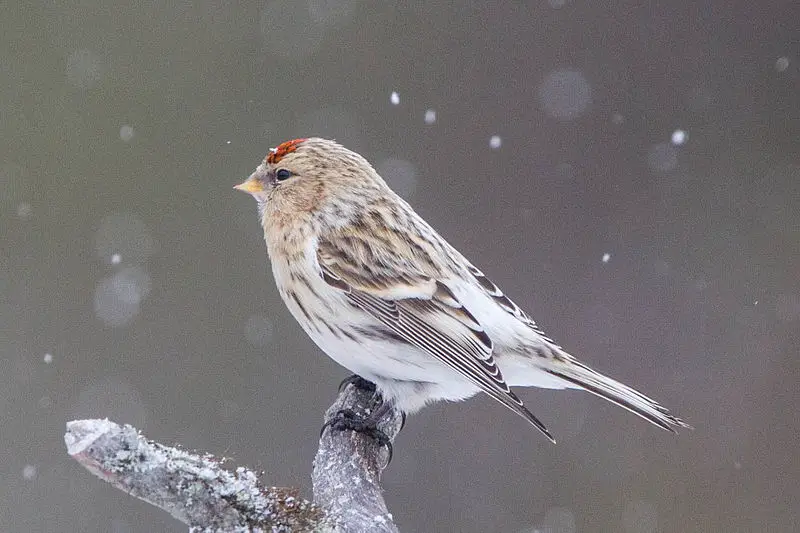
The Arctic redpoll, also known as hoary redpoll, is a species of bird in the finch family.
It breeds mostly in tundra birch forests and has two subspecies- Hornemann’s Arctic Redpoll found primarily in Greenland and neighbouring parts of Canada while Coues’ arctic redpoll can be seen breeding across Northern North America and Palearctic regions.
This small songbird nests on the ground or low shrubs during summer months before migrating south for winter season.
Its main diet consists of seeds but it may occasionally eat insects like caterpillars to supplement its nutrition needs.
These birds have reddish plumage with white patches on their wings which offer them great camouflage against predators such as hawks when they are perched amongst trees or flying over snow covered grounds respectively.Scientific classification:
| Kingdom | Animalia |
| Phylum | Chordata |
| Class | Aves |
| Order | Passeriformes |
| Family | Fringillidae |
| Subfamily | Carduelinae |
| Genus | Acanthis |
| Species | A. hornemanni |
Also Featured In: Birds that Live in Greenland, Tundra Birds
29. Red-Crowned Amazon
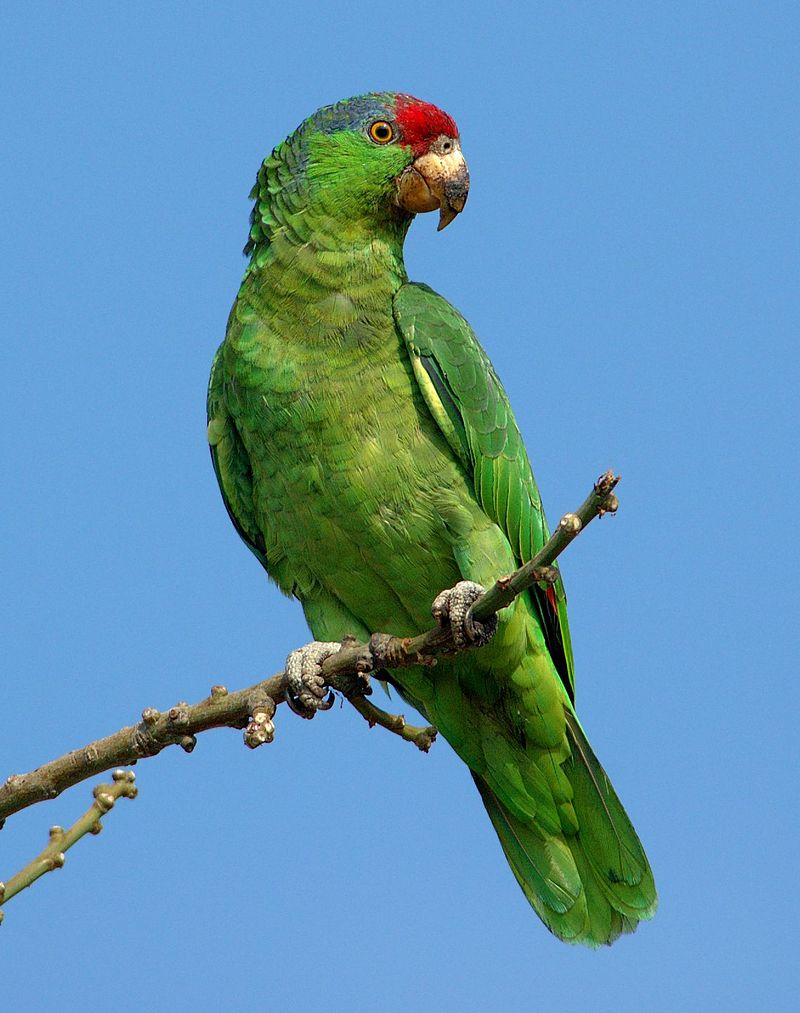
The Red-crowned Amazon is an endangered bird native to northeastern Mexico and possibly southern Texas. This parrot has a distinct red crown, green cheeks, and grayish wings with yellow highlights.
It typically lives in open woodlands near water sources such as rivers or lagoons. The estimated population of the wild stands between 2,000 – 4,300 mature individuals due to habitat destruction and illegal poaching for pet trade purposes.
Conservation efforts are being made by organizations like the IUCN Species Survival Commission Parrots Specialist Group (PSG) which works towards protecting this species from extinction through research projects along its range countries.Scientific classification:
| Kingdom | Animalia |
| Phylum | Chordata |
| Class | Aves |
| Order | Psittaciformes |
| Family | Psittacidae |
| Genus | Amazona |
| Species | A. viridigenalis |
Also Featured In: Parrots Species, Birds You’ll Find in the Rio Grande Valley
30. Painted Bunting
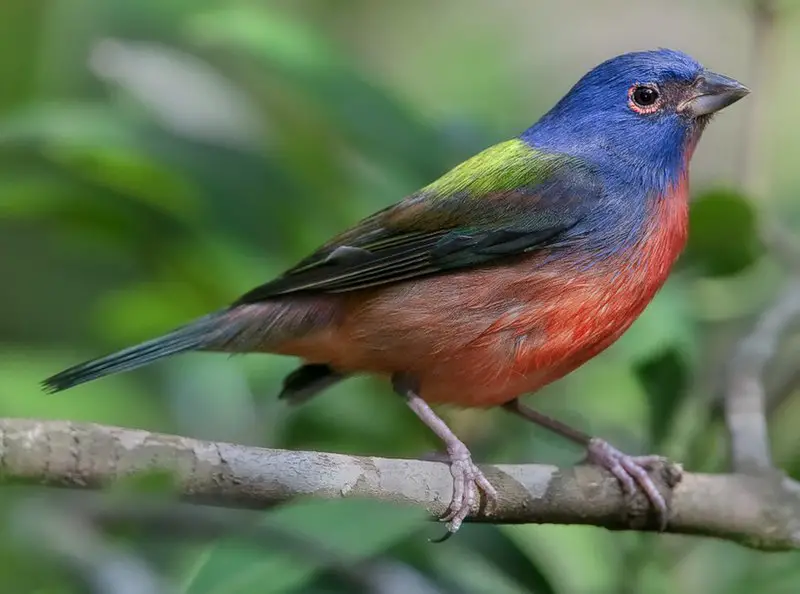
The Painted Bunting is an eye-catching bird from the Cardinal family, native to North America. It was first described by Carl Linnaeus in his eighteenth-century Systema Naturae.
The males of this species are particularly striking; they have brightly coloured plumage which only appears after their second year of life and can be distinguished from female birds through close inspection.
These colourful songbirds are a delight for any avid birder, with their vibrant hues bringing joy to nature lovers everywhere.
They often inhabit woodland areas where there is plenty of seed and insects available for them to feed on – as well as some shrubbery so that they can hide away safely when needed.Scientific classification:
| Kingdom | Animalia |
| Phylum | Chordata |
| Class | Aves |
| Order | Passeriformes |
| Family | Cardinalidae |
| Genus | Passerina |
| Species | P. ciris |
Also Featured In: Texas Birds, Flocks Birds around Us
31. Rose-Breasted Grosbeak
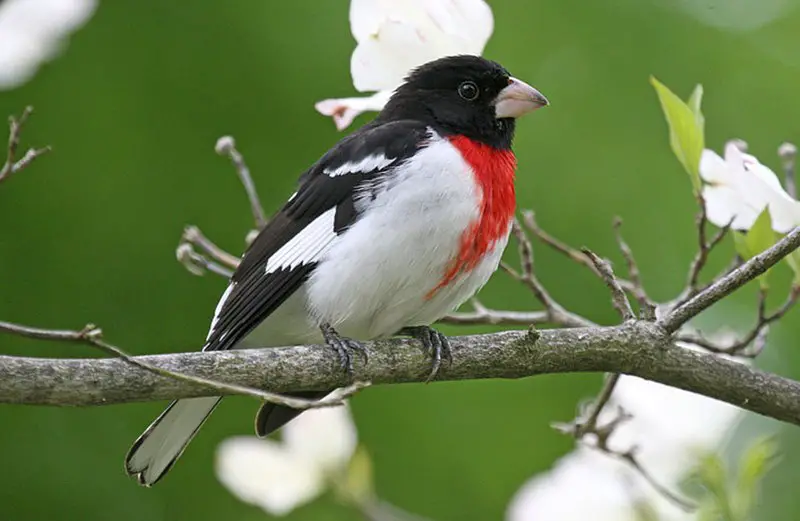
The Rose-breasted Grosbeak is a large, brightly coloured bird belonging to the Cardinal family. Males have black heads and wings, with white breasts boasting a bright rose patch.
Females are more muted in colouring being mostly buffy brown or greyish overall but still featuring the distinctive rose breast patch.The two sexes also exhibit marked sexual dimorphism.
These birds inhabit open woodlands across North America where they feed on seeds gleaned from foliage as well as fruits such as cherries and blueberries during their breeding season which runs from April through August each year.Scientific classification:
| Kingdom | Animalia |
| Phylum | Chordata |
| Class | Aves |
| Order | Passeriformes |
| Family | Cardinalidae |
| Genus | Pheucticus |
| Species | P. ludovicianus |
Also Featured In: Nebraska Birds, Most Common Songs Birds that Live around You
32. Hawaiian Honeycreeper
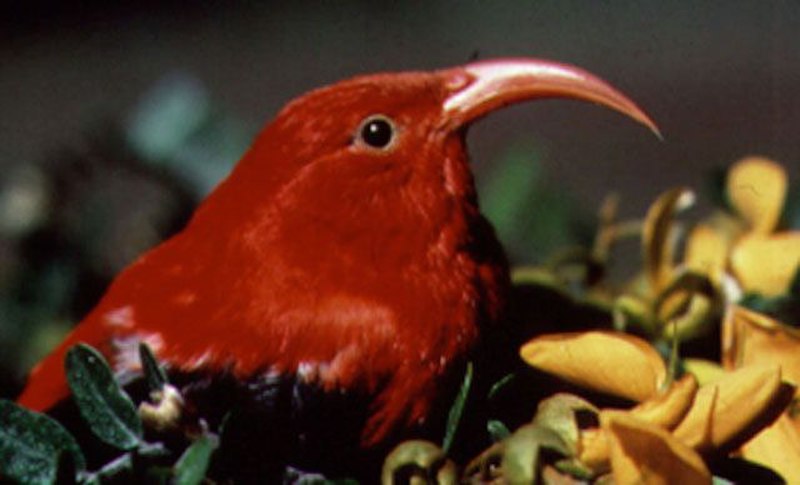
The Hawaiian honeycreepers are a unique group of birds native to the Hawaiian Islands. These small passerines have adapted features not seen in any other finch, making them incredibly diverse.
Sadly, since human arrival in Hawaii many species of these beautiful creatures have been driven to extinction due to habitat destruction and competition with invasive species such as rats and mongooses.
However, conservation efforts are ongoing which aim to protect remaining populations from further decline and reintroduce extinct ones back into their former habitats where possible.
With luck we may one day be able to once again see flocks of brilliantly coloured honeycreepers grace Hawaii’s skies.Scientific classification:
| Kingdom | Animalia |
| Phylum | Chordata |
| Class | Aves |
| Order | Passeriformes |
| Family | Fringillidae |
| Subfamily | Carduelinae |
Also Featured In: Hawaii Birds, Birds of Kauai, Hawaii
33. ʻApapane
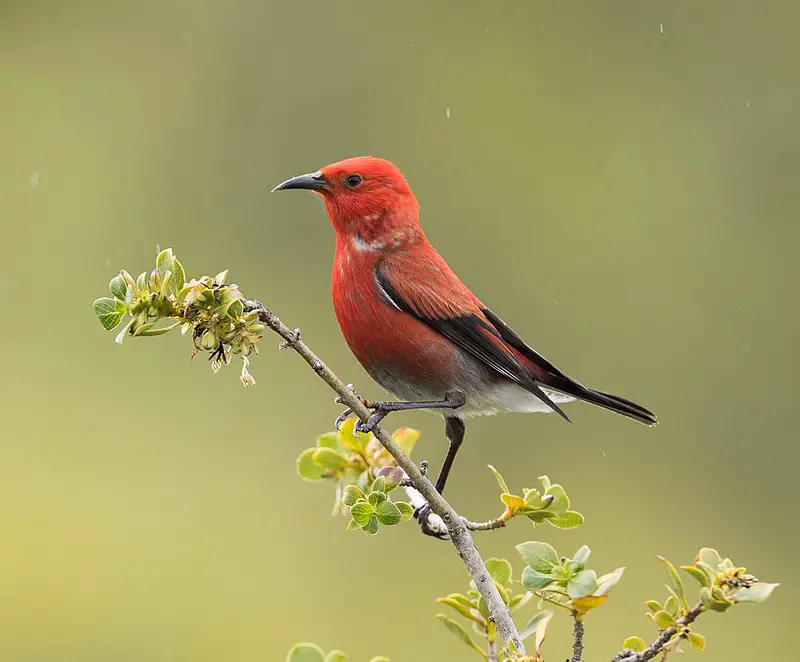
The ‘Apapane is a beautiful bird native to the Hawaiian Islands. It has bright crimson feathers and is a member of the honeycreeper family.
This small species can be found on all main islands, including Hawaiʻi, Maui, Lānaʻi, Kauaʻi, Molokaʻi and Oahu.
These birds are most commonly seen in ōhi’a trees where they feed off nectar from flowers as well as insects that live among the foliage.
They nest high up in these tall hardwood trees and also soar through rainforest treetops looking for food sources with their long wingspan.
The ‘Apapane’s vibrant coloration makes it an iconic symbol of Hawaii’s diverse wildlife landscape; its cheerful presence often bringing joy to visitors who have come to explore this tropical paradise.Scientific classification:
| Kingdom | Animalia |
| Phylum | Chordata |
| Class | Aves |
| Order | Passeriformes |
| Family | Fringillidae |
| Subfamily | Carduelinae |
| Genus | Himatione |
| Species | H. sanguinea |
Also Featured In: Birds that Found in Maui, Most Common Oahu Birds
34. Summer Tanager
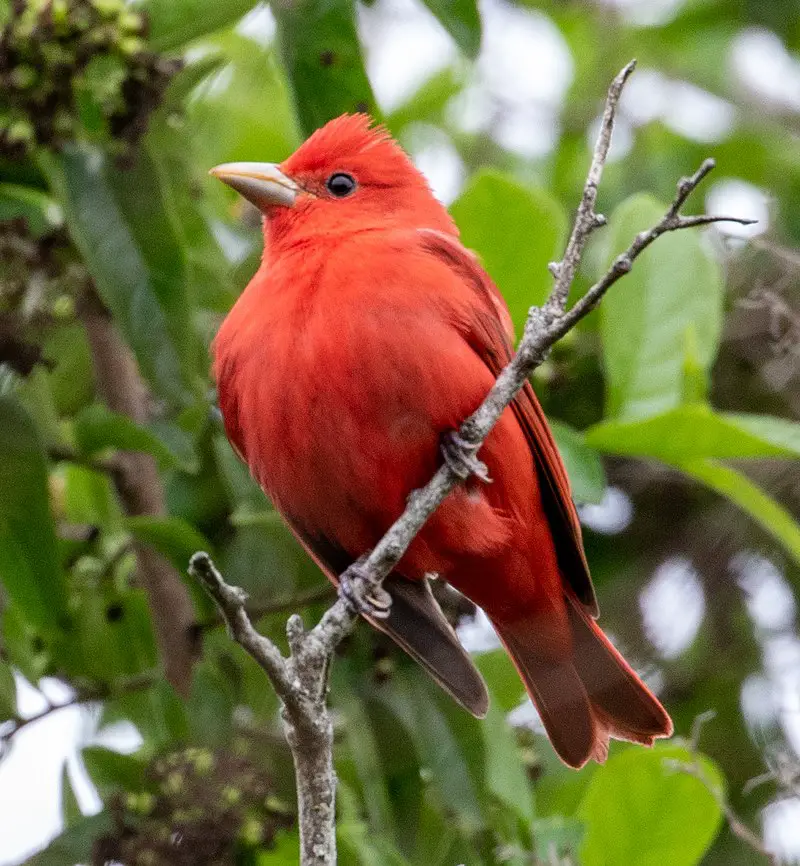
The Summer Tanager is a stunningly beautiful member of the cardinal family. Native to North and South America, this medium-sized songbird features striking red plumage on its back with yellow underparts.
It has a pointed black bill and long tail feathers that can be seen fluttering through the air when it flies.
The species’ vocalizations are quite similar to those of other members of its genus as well, which often include short whistles and chirps in addition to longer songs made up of various phrases or syllables.
With their vibrant colors and melodic voices, these birds make an eye-catching sight any time they appear.Scientific classification:
| Kingdom | Animalia |
| Phylum | Chordata |
| Class | Aves |
| Order | Passeriformes |
| Family | Cardinalidae |
| Genus | Piranga |
| Species | P. rubra |
Also Featured In: birds of Arkansas, Birds Live in Arkansas
35. Elegant Trogon
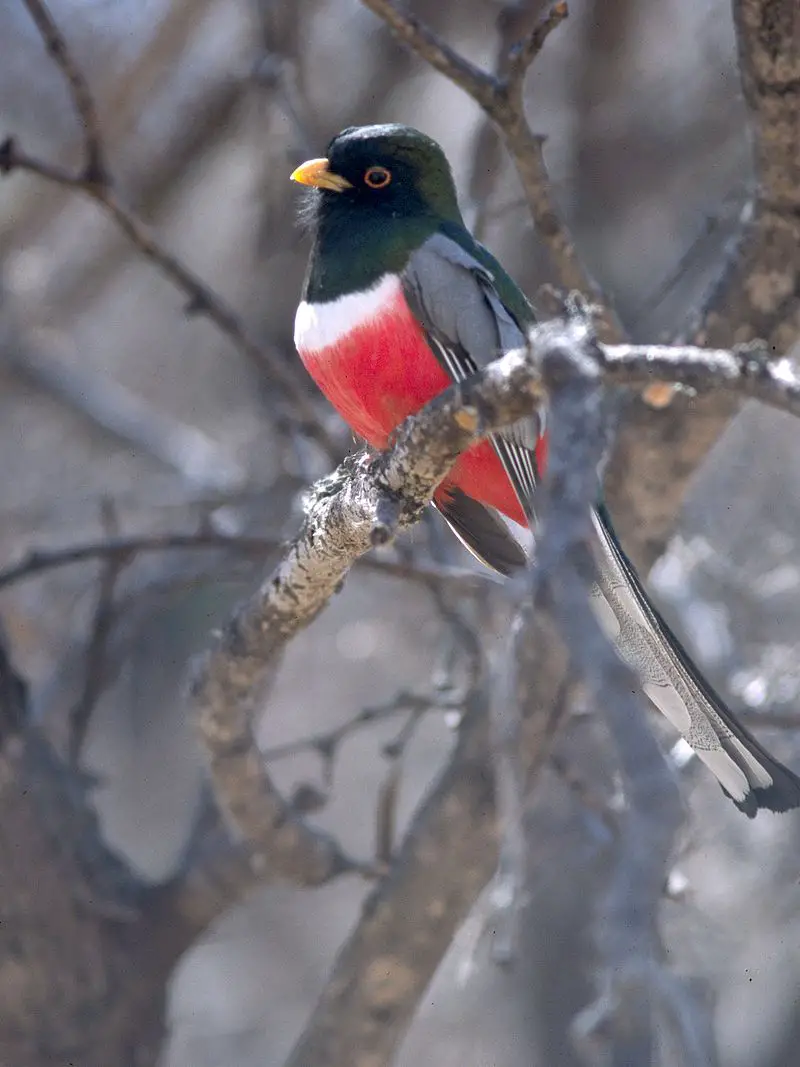
The Elegant trogon is a majestic bird of the Trogon family. It has an impressive coppery-tailed plumage, which gives it its name.
This eye-catching species can be found in Central America and parts of South America and Mexico.
Its five recognized subspecies inhabit different geographical areas with slightly varying physical features and colors on their feathers.
The most distinct among these is Trogon ambiguus, which some classify as a separate species due to its unique characteristics such as more prominent stripes on its head and back, along with duller shades of red compared to other subspecies within the same genus.
Overall this stunningly beautiful omnivore fascinates admirers all over the world for being one of nature’s best works.Scientific classification:
| Kingdom | Animalia |
| Phylum | Chordata |
| Class | Aves |
| Order | Trogoniformes |
| Family | Trogonidae |
| Genus | Trogon |
| Species | T. elegans |
Also Featured In: birds of Arizona, Most Common Birds of Nuevo Leon
36. Pyrrhuloxia
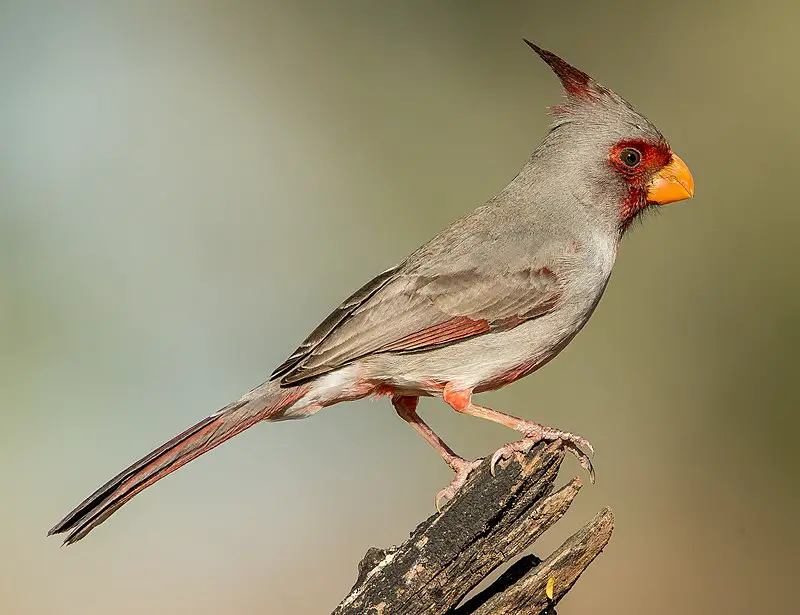
The Pyrrhuloxia, also known as the desert cardinal, is a stunningly beautiful bird native to the American Southwest and northern Mexico.
With its red crest and wings, short stout bill, it closely resembles the Northern Cardinal and Vermilion Cardinal of its same genus.
It has an average size compared to other songbirds in this area at around 18cm long with a wingspan of up to 28 cm wide.
Its diet mainly consists of small insects such as grasshoppers but they will occasionally eat some fruit or seeds too.
The Pyrrhuloxia’s singing ability rivals many birds in that region due to their clear whistles which can be heard from afar on quiet mornings.
The beauty of these birds makes them very popular among birdwatchers who come from all over just for a chance glimpse of one.Scientific classification:
| Kingdom | Animalia |
| Phylum | Chordata |
| Class | Aves |
| Order | Passeriformes |
| Family | Cardinalidae |
| Genus | Cardinalis |
| Species | C. sinuatus |
Also Featured In: Birds that Live in the Deserts, Birds You’ll Find in South Texas
37. Cinnamon Teal
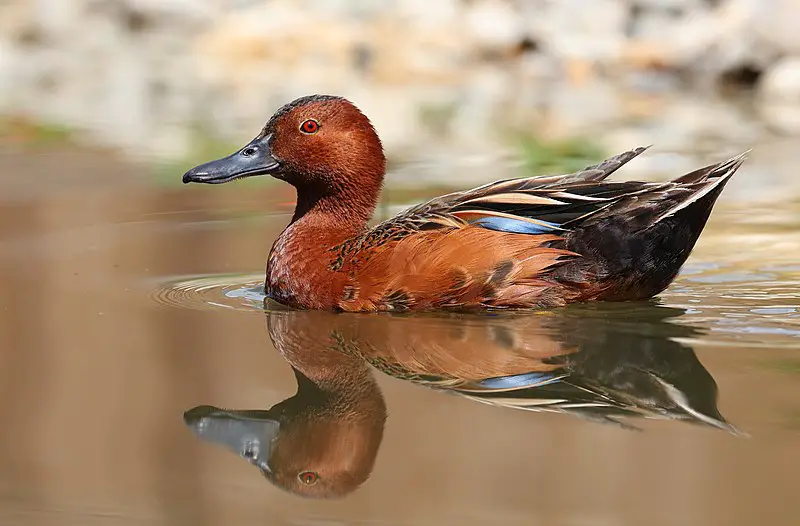
The Cinnamon Teal is a species of duck found in western North and South America. The males are bright reddish-brown while the female’s plumage is duller brown.
They inhabit marshes and ponds, feasting on plants–mainly seeds, roots, stems and leaves. Both genders have dark bills but it’s the male that stands out with its cinnamon-red head & body as well as red eye.
For nesting they prefer areas near shallow water where there are plenty of aquatic vegetation – often making their nests among grasses or cattails to conceal themselves from predators like foxes & raccoons.
These impressive birds also migrate during springtime; travelling far distances across open waters between continents – an incredible feat for such small creatures.Scientific classification:
| Kingdom | Animalia |
| Phylum | Chordata |
| Class | Aves |
| Order | Anseriformes |
| Family | Anatidae |
| Genus | Spatula |
| Species | S. cyanoptera |
Also Featured In: birds of Wyoming, Most Common Lake Birds
38. Hepatic Tanager
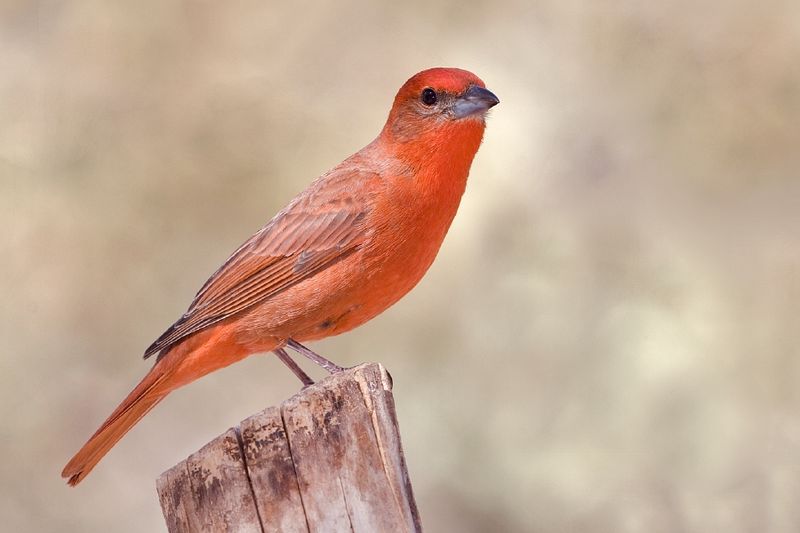
The Hepatic Tanager is a medium-sized bird found in North and South America. It has brownish-red plumage and belongs to the Cardinal family (Cardinalidae) of birds, formerly placed in the tanager family.
The species name “flava” comes from its liver-coloured feathers which are quite striking when seen up close.
Its vocalizations also resemble that of other members of the cardinal family, making them easy to identify by sound.
This bird feeds mainly on insects but also consumes some fruit and nectar too. They typically live alone or with their mate but will gather together at times during migration season for protection against predators.
All in all, this beautiful creature adds colour and life to nature’s orchestra.Scientific classification:
| Kingdom | Animalia |
| Phylum | Chordata |
| Class | Aves |
| Order | Passeriformes |
| Family | Cardinalidae |
| Genus | Piranga |
| Species | P. flava |
Also Featured In: Red Birds, Summer Birds that Live around Us
39. Northern Flicker
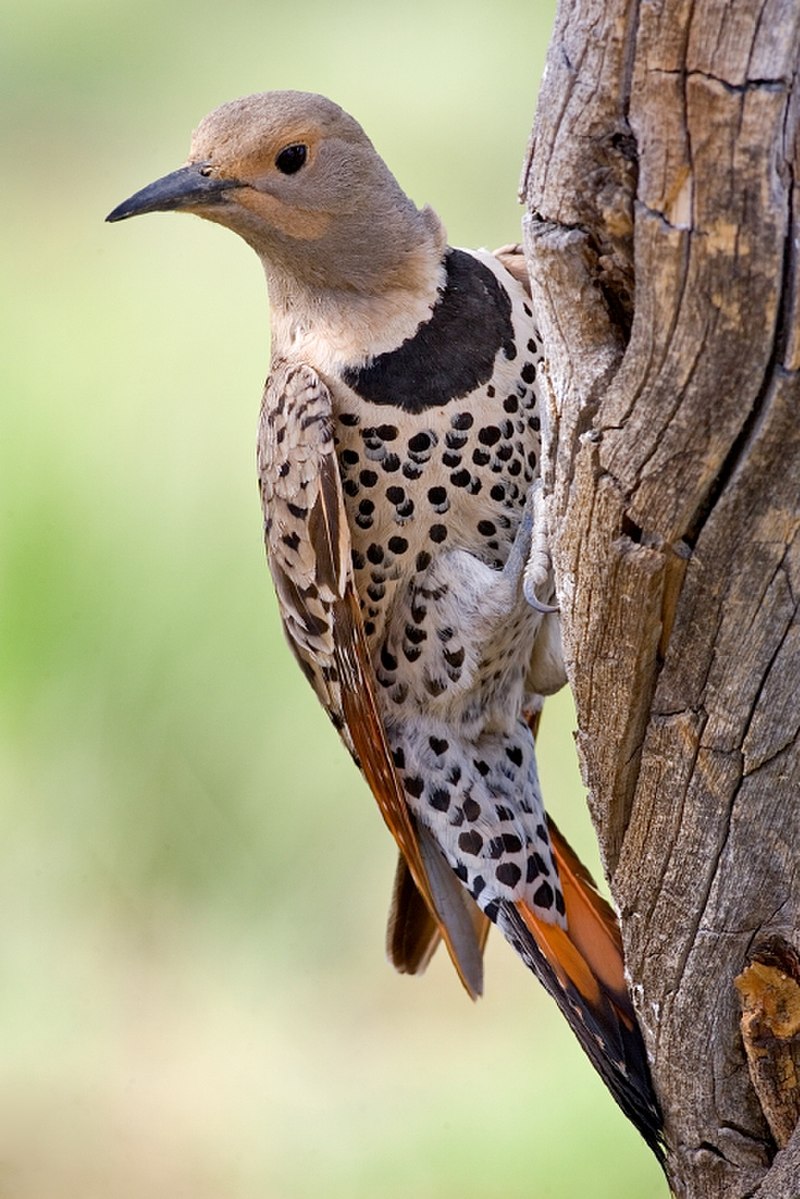
The Northern flicker is a woodpecker species found in North America, Central America, Cuba, and the Cayman Islands. This medium-sized bird is known for its unique migration behavior.
Over 100 common names are used to refer to the Northern flicker, one of them being “yellowhammer”. It is a beautiful bird with distinctive markings and a colorful plumage.
The Northern flicker is an important species in its ecosystem and plays a key role in maintaining a healthy balance in the environment.
Despite being a woodpecker, the Northern flicker has a diverse diet that includes insects, fruits, and seeds.
It is fascinating to observe this bird as it pecks at trees in search of food, communicates with its unique vocalizations and performs its incredible aerial displays.
The Northern flicker is truly a remarkable bird species that is worthy of our admiration and protection.Scientific classification:
| Kingdom | Animalia |
| Phylum | Chordata |
| Class | Aves |
| Order | Piciformes |
| Family | Picidae |
| Genus | Colaptes |
| Species | C. auratus |
Also Featured In: Birds Commonly Found in New York, Common Birds in the Cities